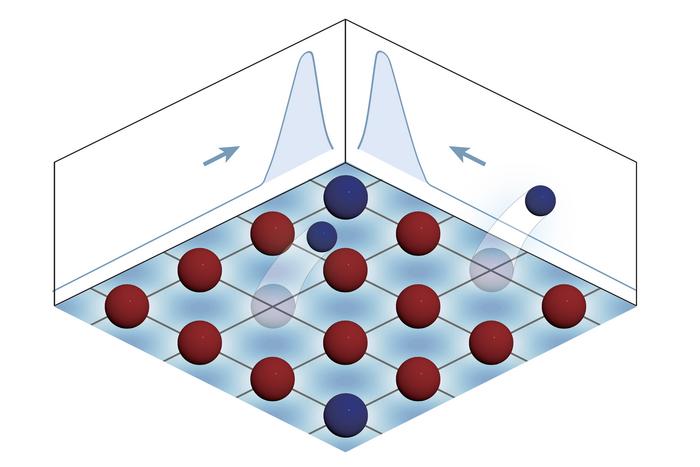
A collaborative research team from The Hong Kong University of Science and Technology (HKUST) and Peking University (PKU) has achieved a significant breakthrough in the field of quantum physics by conducting a pioneering quantum simulation of the non-Hermitian skin effect in two-dimensional systems. This simulation, utilizing ultracold fermions, marks a critical advancement in our understanding of quantum dynamics in higher dimensions. The non-Hermitian skin effect refers to a phenomenon where eigenstates of an open quantum system preferentially accumulate at its boundaries, raising intriguing questions about the implications of non-Hermitian dynamics in quantum mechanics.
Typically, quantum mechanics operates within the framework of Hermitian models, which describe isolated systems where energy is conserved, and eigenvalues remain real. However, when a quantum system interacts with its environment, the Hermiticity of the model can break down. This breakdown leads to the description of open quantum systems through non-Hermitian Hamiltonians. These non-Hermitian descriptions allow researchers to delve into complex phenomena associated with quantum information processing, non-trivial topological phases, and even the physics of black holes. Despite these developments, many aspects of non-Hermitian dynamics remain poorly understood, especially when considered in higher-dimensional contexts.
Working collaboratively, physicists from HKUST and PKU successfully simulated the non-Hermitian skin effect within a two-dimensional framework, utilizing ultracold fermions confined in optical lattices with tunable dissipation. This innovative approach not only allows for the study of non-Hermitian dynamics in higher dimensions but also provides a platform for investigating quantum many-body systems. Previous investigations into the non-Hermitian skin effect were largely confined to lower dimensions, making this demonstration a significant leap forward in experimental quantum physics.
The research, set to be published in the prestigious journal Nature on January 8, 2025, represents a substantial step in characterizing the non-Hermitian skin effect in a two-dimensional topological band structure. Employing ultracold fermions that are manipulated through spin-orbit coupling, the researchers have unveiled new insights into the interplay between non-Hermiticity, symmetry, and topological properties in quantum systems. According to Professor JO Gyu-Boong, the lead researcher at HKUST, this experimental setup enables an exploration of fundamental questions related to non-Hermitian quantum dynamics, particularly through the lens of many-body systems as opposed to solely classical frameworks.
Professor LIU Xiong-jun of PKU, a prominent contributor to the project, echoed the sentiment of the importance of this research. He commented on the necessity of exploring the intersection of non-Hermitian dynamics with established Hermitian phenomena such as curved spaces and black holes. This exploration is critical as it opens new avenues for understanding exotic states in quantum mechanics, particularly in the realm of higher-dimensional systems. The framework established by this research positions itself as a versatile tool for investigating a variety of high-dimensional quantum phenomena that extend beyond traditional condensed matter physics.
Despite the groundbreaking findings, the research team acknowledges that numerous questions about the non-Hermitian skin effect remain unanswered. The inquiry into whether a general topological understanding of the NHSE exists and how topology influences its manifestation are areas of ongoing investigation. The research group emphasized that their work lays foundational groundwork for addressing these queries in future studies.
The study also showcased the innovative methodologies behind the experimental setup, including the generation of a two-dimensional non-Hermitian topological band through the controlled dissipation of ultracold fermions. This distinctive approach allows for intricate manipulations of the quantum state of the system, furthering the team’s ability to investigate the nature of non-Hermitian phenomena in a controlled environment. With the advancement of techniques in quantum optics and atomic physics, researchers are now better equipped than ever to explore the complexities of non-Hermitian systems.
The implications of this research extend beyond theoretical interest; they could significantly impact practical applications in quantum technology. Many-body systems that exhibit non-Hermitian characteristics may yield insights into quantum computing and information transmission, which are poised to revolutionize technological landscapes. The unique properties characterized by non-Hermitian systems provide an avenue for crafting novel quantum information protocols and developing robust quantum devices.
As this field continues to develop, the researchers signal a call to action for the community to further explore the vast implications of non-Hermitian quantum dynamics. Their work highlights the importance of interdisciplinary collaboration, merging principles from condensed matter physics, quantum mechanics, and information theory. By fostering collaboration across diverse scientific communities, the researchers believe that a more comprehensive understanding of non-Hermitian systems will emerge, paving the way for innovative discoveries.
With the publication date approaching, anticipation is building within the scientific community. Researchers and scholars alike are eager to dissect the findings and methodologies presented in this study, as they could serve as a catalyst for new research initiatives into the complex world of non-Hermitian quantum physics. The team’s commitment to further exploration signifies a promising future for the understanding of quantum systems, potentially bridging the gap between theoretical predictions and experimental validations.
In conclusion, the study represents an extraordinary leap forward in our grasp of non-Hermitian dynamics within quantum systems. By leveraging ultracold fermions and innovative experimental methodologies, the research team has not only demonstrated the non-Hermitian skin effect in two dimensions but has also established a robust platform for future explorations in quantum physics. The results herald numerous possibilities for both theoretical advancement and practical applications, urging the scientific community to engage with the challenges and questions presented by this foundational work in higher-dimensional non-Hermitian mechanics.
Subject of Research: Non-Hermitian skin effect in ultracold fermions
Article Title: Two-dimensional non-Hermitian skin effect in an ultracold Fermi gas
News Publication Date: January 8, 2025
Web References: http://dx.doi.org/10.1038/s41586-024-08347-3
References: Not applicable
Image Credits: Credit: HKUST
Keywords
Quantum information science, Fermions





